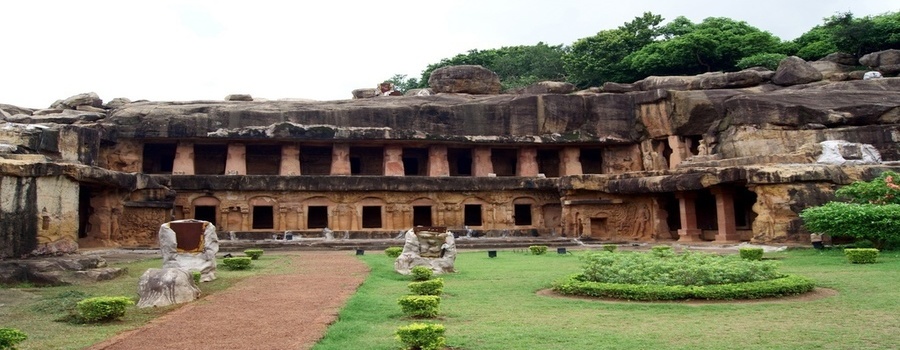

Buddhist Tour of Orissa
Places to See: Bhubaneshwar - Puri - Konark

Buddhist Tour of Orissa: Complete Itinerary
Day 01: Arrive Bhubaneshwar
Arrive Bhubaneshwar; garland welcome; assistance and transfer to Hotel.
Bhubaneshwar is the capital of the ancient kingdom of Orissa, and is famous as the temple city of India. Travel through Orissa is a melange of art, architecture and long-established customs. City tour of Bhubaneswar, which has some stunning temples clustered around the Bindusagar Tank. Of the original 7000 only 500 remain dating from the 7th century to the 11th century AD. Of these the most outstanding is the 11th century Lingaraja Temple, which celebrates the zenith of Orissa art; and the late 10th century beautifully decorated Muktesvara Temple, which marks the end of the phase of temple building in Orissa. Overnight at hotel.
Day 02: Bhubaneshwar – Khandagiri – Udaygiri – Dauli – Puri (74kms/ 2hrs approx)
Breakfast at hotel, drive to Puri. Enroute visit Khandagiri and Udaygiri Caves (first century BC): Just 7kms west of Bhubaneswar are the twin hills of Khandagiri and Udaygiri, the next major Orissan historical monument after Ashoka's rock-cut edict.
The rocks of the Khandagiri and Udaygiri hills were carved and tunneled, to create this multi-storied ancient apartment residence for Jain monks. They were the work of the first known Orissan ruler, King Kharavela, and probably begun in the first century BC. Kharavela was a king of the Mahameghavahana dynasty, who is known for expansion of the Kalinga empire and his installation of public improvements, such as canal systems. His queen was evidently quite a patron of the arts, and probably had much to do with the impressive sculptural decoration of the caves.
Dhauli:
where the Mauryan Emperor Ashoka renounced violence and embraced the
teachings of Buddha. We visit the Peace Pagoda known as Shanti Stupa
built in early 1970s by the Japanese. We also stop at two ancient
rock edicts, today eclipsed by the presence of the Pagoda. Dating
from 260BC they outline Ashoka's detailed instructions to his
administrators to rule with gentleness and fairness.
Shanti
Stupa at Dhauli the serenity of the place and the legacy of Buddhism
motivated the Kalinga Nippon Buddha Sangha, under the guidance of
Guruji Fujii, Founder President of Nipponzan Myohoji of Japan to
establish a Peace Pagoda or Shanti Stupa at Dhauli along with the
construction of the monastery called Saddharma Vihar in early
seventies of 19th century. Along with the Ashokan Edicts, the Peace
Pagoda and modern Buddhist Monastery, Dhauli offers the visitors
small-rock cut caves, Hindu temples of early medieval period and a
renovated Siva temple known as Dhavalesvara on top of the hill are
added attractions.
Arrive Puri check in at hotel. Evening free to relax on the beach. Overnight at hotel.
Day 03: Puri – Ratnagir – Udaigiri – Lalitgiri – Puri (150kms 3hrs approx one way)
Breakfast at hotel, drive to visit Ratnagiri, Udaigiri & Lalitgiri. Ratnagiri in the Birupa river valley in the district of Jajpur is another famous Buddhist centre. The small hill near the village of the same name has rich Buddhist antiquities. A large-scale excavation has unearthed two large monasteries, a big stupa, Buddhist shrines, sculptures, and a large number of votive stupas. This excavation revealed the establishment of this Buddhist centre at least from the time of the Gupta king Narasimha Gupta Baladitya (first half of the sixth century A.D.). Buddhism had developed at this place - unhindered upto the 12th century A.D.
It is stated in the Datavamsa (an early and authentic Buddhist text from Sri Lanka) that it was at Ratnagiri that the relics of the Buddha were temporarily kept while they were being shifted from Dantapura, the capital of Kalinga, or ancient Orissa, to Anuradhapura in Sri Lanka.
According to the text, soon after the Buddha's Mahaparinirvana, orthe Great Cessation at Kushinagara, his left canine was carried to Kalinga by one of his close disciples Khema Thera, and was presented to its king, Brahmadatta. Brahmadatta had constructed a grand chaitya (the Buddhist prayer hall) in the heart of his capital Dantapura. The chaitya that had enshrined the relic is worked upon in gold and lustrous gems.
In the beginning, this was an important centre of Mahayana form of Buddhism. During the 8th-9th century A.D., this became a great centre of Tantric Buddhism or Vajrayana art and philosophy. Pag Sam Jon Zang, a Tibetan source, indicates that the institution at Ratnagiri played a significant role in the emergence of Kalachakratantra during the 10th century A.D. This is quite evident from the numerous votive stupas with reliefs of divinities of the Vajrayana pantheon. Separate images of these divinities and inscribed stone slabs, and moulded terracotta plaques with dharanis found in the excavation at Ratnagiri.
Presently this university of Buddhist learning is found in ruins that attract a number of visitors every year. For lovers of art and architecture, lay tourists as well as special groups, Ratnagiri offers in its magnificent ruins, a large brick monastery with beautiful doorways, cella, sanctum with a colossal Buddha figure, and a large number of Buddhist sculptures. There is a smaller monastery at the place along with a stone temple, brick shrines and a large stupa with numerous smaller stupas around. Evening back to Puri. Overnight at hotel.
Day 04: Puri –Konark – Pipli – Puri (45kms/ 1hrs one way)
Breakfast at hotel, excursion to visit to the Chariot of the Sun God Temple (UNESCO's World Heritage Site), built by King Langula Narasimha Deva in the 13th century AD during the golden era of Orissan art. This temple, among the crowning works of Orissan architecture and sculpture, is sheer poetry in stone. Everyday the Sun God rises from the horizon, across the shimmering blue waters of the Bay of Bengal, and casts the warmth and luminosity of his revitalising rays on the sanctum sanctorum, circling the temple during the course of the day, illuminating the three brilliant images of the sun - in the morning, at mid-day and in the evening, as day makes way for the night. As you approach the water, you will see rising from the golden sandy beach, one of the country's most vivid archaeological treasures - the Surya Mandir (Sun Temple). For a millennium, this temple served as a beacon to the ancient and medieval mariners. Despite the fact that the Black Pagoda, as it was referred to by European soldiers who wanted to distinguish Konark from the whitewashed Jagannath Temple in Puri, lies in ruins, the structure is magnificent.
Pipli Artist Village; The villagers of Pipli produce applique art, a process of cutting coloured cloth into shapes of animals, birds, flowers leaves gods, goddesses and other decorative motifs and stitching them over a piece of cloth. These creations are then fabricated into lampshades, handbags, cushion covers or even garden umbrellas. A famous example is the enormous applique' canopies above the reigning deity of Puri, Lord Jagannath. Overnight at hotel.
Day 05: Puri - Chilika Lake (at Satpada) - Puri (90kms both way)
Breakfast at hotel, Breakfast at hotel, visit Jagannath Temple: A visit to Puri is incomplete without a visit to the Jagannath temple, one of the four sacred dhams in the Hindu religion. The magnificent temple is dedicated to the Lord of the Universe. Built in the 12th century, it is considered to be one of the tallest (65m) temples in India. Modeled along the Kalinga style of architecture, the temple consists of the Jagmohanor hall and the Deul or the main shrine, in front. The Nata Mandir and the Bhoga Mandir were built much later in the 14th and 15th century, in the classic Orissa style. Gundicha Ghar: The Gundicha Ghar having been the house of Lord Krishna's aunt, Gundicha is another important site to visit in Puri. It is believed that, the Lord stays here for 9 days during the famous Rath yatra or chariot-pulling festival of Puri. On the day of the Rath Yatra, Jagannath, Balabhadra and Subhadra are ceremoniously taken around in gorgeously decorated wooden raths (chariot) all the way from the Jagannath temple to the Gundicha temple where they are welcomed by their aunt by feeding them podapitha (rice cakes).
Later excursion to visit Chilika Lake (at Satpada), boat cruise inside the lake, get a chance to see the Dolphins. Chilika Lake: is the largest wintering ground for migratory birds on the Indian sub-continent. The lake is home to a number of threatened species of plants and animals. The lake is an ecosystem with large fishery resources. It sustains more than 150,000 fisher-folk living in 132 villages on the shore and islands. The lagoon hosts over 160 species of birds in the peak migratory season. Birds from as far as the Caspian Sea, Lake Baikal, Aral Sea and other remote parts of Russia, Kirghiz steppes of Mongolia, Central and southeast Asia, Ladakh and Himalayas come here. These birds travel great distances, but it must be stressed, that the migratory birds probably follow much longer routes than the straight lines, possibly up to 12,000 km, to reach Chilika River. Overnight at hotel in Puri.
Day 06: Puri – Bhubaneswar (60kms/ 2hrs approx)
Breakfast at hotel, drive to Bhubaneswar, direct transfer to airport to board flight for onward destination.
Searching Availability...












